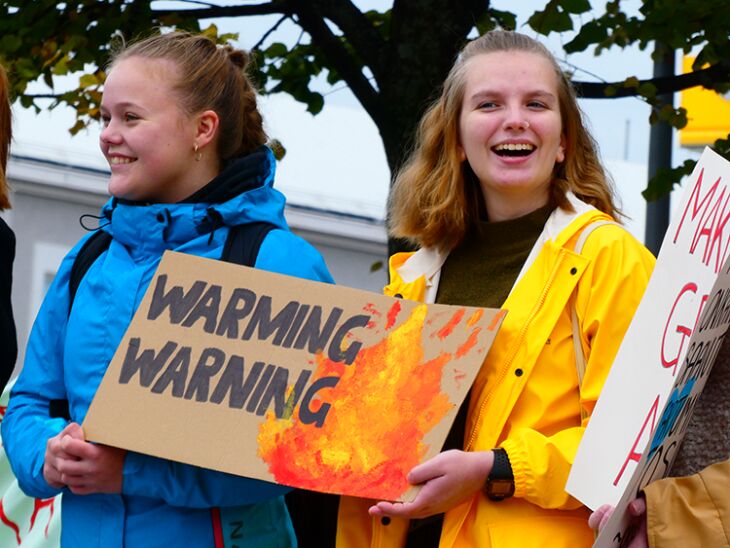Interview: Melina Antonia Buns
Environmental historian Melina Buns has recently defended her thesis Green Internationalists: Nordic Environmental Cooperation, 1967-1988 and graciously took the time to answer some of our questions about her research.
 Source: Private photograph.
Source: Private photograph.
You recently defended your doctoral thesis titled Green Internationalists: Nordic Environmental Cooperation, 1967-1988; what was it about this subject which engaged you?
There were several aspects that motived me to study this subject, but I think that two aspects were most central. The first aspect was a curiousness emerging from contemporary nation branding practices and outside images of the Nordic region as particularly environmentally friendly. In several scholarly works, the Nordic countries – and sometimes perhaps only Sweden or Denmark – were singled out as particularly ‘green’ countries, with strong civil societal engagement and widespread environmental awareness, extensive legislation on environmental protection, and eager politicians driving international environmental policies. Yet despite all these references to a long tradition of this environmental engagement, the deeper I was digging into the literature, the actual historical research on Nordic environmental history and policies proved in fact rather limited compared to other ‘environmental’ countries, such as the US or Germany. This dissonance, I thought, was rather puzzling: one the one hand, Nordic environmental ‘pioneering’ was considered self-evident and, on the other hand, Nordic environmental history of the 20th century was rather underdeveloped. I first discovered this scholarly void during my time as an MA student at Aarhus University, where I did a research project on the Danish anti-nuclear movement, where I focused on the transnational dimensions, which I think is another aspect that was very important for this project and my scholarly interests in general. What I could recognised in the historical work that did exist on Nordic environmental issues was that it was particularly compartmentalised along national borders, while environmental pollution is border-crossing per se. This is for instance also why international organisations have played a central role in the development of environmental policies, as other research has shown – something that was also reflected in contemporary Nordic environmental branding practices for which the Nordic Council and the Nordic Council of Ministers were central. So, the first aspect was to actually scrutinise the existence and then to analyse a genuinely Nordic history of environmental policies. The second aspect was an interest in international cooperation on environmental issues: what are the motives for countries to cooperate on environmental pollution and protection; what purpose does this cooperation serve, is it actually environmental or does it serve other interests; how are countries using the international scene to advance national interests; what problems emerge; who are driving actors; what environmental issues were addressed, and which were not? Such questions obviously also relate to contemporary environmental and climate policy-making, and might shed light on why certain environmental problems do not receive the political attention and measures their urgency requires. Since I started this PhD project less about a year after the Paris Convention had been signed, climate change has received unprecedent attention – not least due to Fridays for Futures and fast proceeding climatological changes leading to droughts and floodings as we could witness this summer. This now raises the question as for why the international community has not done anything to mitigate climate change during the past three decades? What I could show in my research – which in fact is also the first historical research on Nordic environmental policies and cooperation – is that this international engagement was very often driven by economic rather than ecological concerns, and at the same time economic arguments were often used oppose extensive environmental regulations. In this context, history has an obviously high relevance for contemporary societies and policy-making, where economic arguments often play a central role when arguing against environmental and climate change policies. Eventually, it was a rewarding combination of a problem-oriented and a historiographical driven research that drove me to analyse a very prominent aspect of Nordic cooperation, which had not been studied by previous research.
What is in your opinion the most important aspect of the Nordic environmental cooperation throughout history?
Rather than one most important aspect, I would say that there are several developments that successively have formed Nordic environmental cooperation throughout history. Let me highlight four aspects in particular. Firstly, there was an early institutionalisation of Nordic environmental cooperation in the Nordic Council, which happened parallel to the creation of environmental protection agencies and ministries at national level at the turn of the 1970s. The creation of Nordic committees for environmental issues laid the foundation for the transbureaucratic and transnational cooperation that developed in the following decades and exists until today. Secondly, in 1974, Denmark, Finland, Norway, and Sweden signed the Nordic Environmental Protection Convention with the aim to prevent transboundary pollution. By international standards, the convention was in fact ambitious and novel, as it for instance established the polluter pays principle – which means that the one causing pollution to others has to pay for the damage that has occurred – across the Nordic region. This meant that for instance Norwegian citizens would be eligible for economic compensation by a Swedish polluter. At the same time, the convention also provided a blueprint for possible future environmental conventions at international level. Thirdly, Nordic environmental cooperation covered a broad variety of topics, continuously developing and changing, encompassing pollution policies, education, and research. And finally, Nordic environmental cooperation served as a coordinating and informing forum for Nordic cooperation within other international organisation where it served both national interests and the (self-)promotion of the Nordic region as global environmental frontrunners. Depending on the environmental issue at stake, for instance transboundary air pollution, this latter aspect has been more important than the actual Nordic cooperation at administrative matter, mainly because the source of the environmental degradation lay outside the Nordic region. It is here, one finds the beginnings of contemporary Nordic environmental branding practices and perceptions.
To what extent do you find that the Nordic countries might use climate awareness or the fight against climate change to strengthen their national brands?
Without having studied this systematically, I think it is very obvious that awareness for the environment and climate feature very prominently in contemporary branding strategies. So, there is no doubt that a ‘green’ image is used to strengthen the respective national brands – an image that is often justified by the long history of Nordic environmental cooperation itself.[1] Yet what one could observe during the previous years with climate change rising on the political agenda is the dissonance between rhetoric and practice – or what we also might call ‘greenwashing’. And most obviously hypocritical is Norway’s prominent political engagement in climate change mitigation and adaption policies and the national position towards its petrochemical industry, which a majority of its political parties is not willing to divest and terminate. Yet all the Nordic countries have to change their infrastructure systems, consumption patterns, growth understandings and ideologies fundamentally in order to contribute to meeting the 1.5 degrees target, which according to the most recent report of the IPCC will most likely not only be reached but also exceed. So, what will be interesting to observe is rather how the Nordic countries each on their own way actually realise policies that not only adapt to climate change but also mitigate it as far as still possible – and thus live up to this alleged environmental brand which they all cultivate. Because right now it is very obvious from the outside that rhetoric and practice do not correspond, and in the long run I would guess that this would rather have contrary results.
Do you find that countries with a stronger national brand in relation to climate activism, such as Sweden with Greta Thunberg, are dominant in the branding of the Nordic region as environmentally conscious countries?
The question of whether there was a hegemon in Nordic environmental cooperation is in fact an interesting one. If one looks at research, it is usually Sweden, and sometimes Denmark, that get singled out and listed together with Germany and the Netherlands as particularly environmental countries. While Greta Thunberg has strengthened this image of Sweden as a particularly environmentally conscious society for the past three years now, the fact that Sweden was among the first countries to establish an environmental protection agency in 1967 and that it hosted the world’s first global conference on the environment, the United Nations Conference on the Human Environment in 1972 present obvious historical reasons for this perception from both the inside and outside. Similarly, Swedish scientists and politicians were driving forces for the emergence of Nordic environmental cooperation in the late 1960s, and the reasons for this might be several, such as higher living standards and levels of consumption due to a different Second World War experience. But to say that Sweden was dominating Nordic environmental cooperation would be wrong. Rather one can observe that certain environmental issues were more important for one country than for another. And I think this is also reflected in today’s national brands: the Danish brand, for instance, is particularly well-known for its renewable energy technologies, whereas others might be stronger on biodiversity, and sustainability. In general, however, Nordic environmental brand(s) have barely been studied despite their timely and multifaceted characters.
Lastly, what do you imagine the future looks like for Nordic climate activism? “Greenwashing” is fast becoming a central term to the current climate debate, how might this factor in?
It is difficult to say what the futures of Nordic climate activism(s) might look like. Back in 2017, when I was working for a Danish NGO, I was doing an interview with Jeppe Læssøe, at that point professor MSO at DPU where he was researching socio-cultural processes of change, as I was humbled by the lacking interest, engagement, and activism of my own and younger generations.[2] One year later, Greta Thunberg started her protest in front of the Swedish parliament, which as we all know has developed into a global movement. While this protest has been actively used for the Swedish brand, as you pointed to in your question above, the fact that this is a global movement also offers possibilities for comparison which might very bluntly reveal national practices of ‘greenwashing’. A recent example of this is for instance the contrary court ruling on petrochemical activity in Norway and the Netherlands. While the Norwegian climate activists lost their case on the granted oil exploration licences in the Barents Sea at the Norwegian Supreme Court in November 2020, in May 2021, Dutch activists won their case over Royal Dutch Shell which now has to cut carbon emissions by 45% by 2030. Such contrasting developments not only point to different legal and political systems, but also to diverse histories of environmental activism, which contemporary climate activism builds upon. It will be very interesting indeed to follow how this activism will develop over the coming years at global, European, and Nordic level, and how different or similar this development might be within the single Nordic countries or among them. Just recently, at the end of August 2021, the Nordic branches of Extinction Rebellion jointly protested in Norway with several non-violent civil disobedience actions throughout a whole week, which not led to 2,1 mio NOK in fines, but also to widespread public and media attention.[3] For me as an historian of Nordic cooperation, this transnational interaction is very interesting to follow, not only in contemporary developments, but also at historical scale in my forthcoming NFR postdoc project ‘Nuclear Nordics’.
[1] Programme for Nordic Co-operation on the Environment and Climate 2019-2024 (Copenhagen: Nordic Council of Ministers, 2018), 6f. http://norden.diva-portal.org/smash/get/diva2:1268544/FULLTEXT01.pdf
[2] https://raastof.ve.dk/har-klimaet-tabt-sine-aktivister/
[3] https://e24.no/det-groenne-skiftet/i/Xqov4n/extinction-rebellion-129-aktivister-arrestert-21-millioner-i-boeter
















